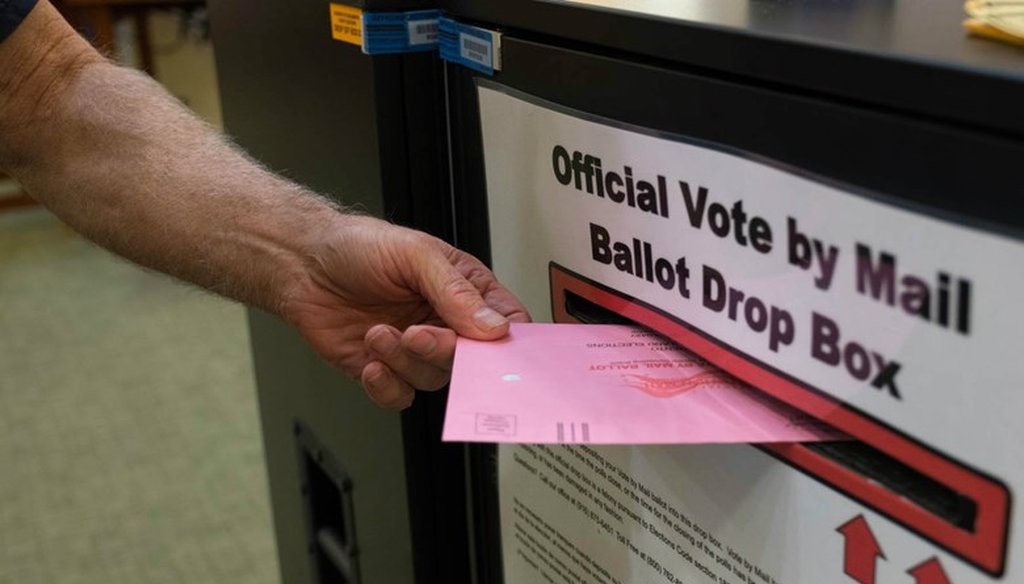Stand up for the facts!
Our only agenda is to publish the truth so you can be an informed participant in democracy.
We need your help.
I would like to contribute

A voter returns a vote by mail ballot in California. Andrew Nixon / CapRadio
If Your Time is short
- Several studies concluded that states with vote by mail saw a modest increase in voter turnout.
- Those reports show this type of voting does not appear to give an advantage to one political party over another.
- But the studies do not conclusively prove that introducing vote by mail alone is responsible for boosting turnout.
Recent claims by President Trump, that voting by mail leads to fraud and hurts Republicans, have put a spotlight on the topic. They’ve also inspired pushback from Democratic leaders in California, where generations of voters have used "absentee ballots," and 72 percent of all ballots cast in the state’s March primary were by mail.
On Friday, California Secretary of State Alex Padilla claimed on the national radio show The Takeaway that vote-by-mail has helped boost voter turnout "not just in blue states like California, but in red states and purple states across the country."
Here’s Padilla’s full statement in context:
"Here’s the truth about vote by mail: It’s a proven practice that’s not only safe and secure and efficient for administrators, it’s tremendously convenient for voters and has helped increase voter turnout rates and not just in blue states like California, but in red states and purple states across the country. So to suggest that vote-by-mail is not inherently safe, is not only false, frankly it’s also an attempt to distract."
We examined Padilla’s assertion that mail-voting aids turnout in so-called blue, red and purple states. We found there’s some circumstantial evidence to support it, though it’s not necessarily conclusive.
Background on voting-by-mail
There’s a patchwork of voting methods across the nation.
Just five states regularly conduct universal vote-by-mail elections: Colorado, Hawaii, Oregon, Utah and Washington. In those states, ballots are automatically sent to all registered voters, who then fill them out and mail them back. Twelve states allow counties to opt-in to mail-voting or allow it for certain elections, but not others.
Voters in another 29 states have the option to vote-by-mail in federal elections, but must request such a ballot, according to an article by FiveThirtyEight.
In California, voters have used mail ballots since 1962 and they’ve become increasingly popular: The majority of ballots cast in each of the past four general elections and eight primaries were by mail, according to the Secretary of State’s Office website.
Earlier this month, California Gov. Gavin Newsom signed an executive order requiring all counties in the state to send vote-by-mail ballots for the November 3 General Election to all registered voters.
It was the first such order by a state tied to COVID-19 and concerns about in-person voting. But that doesn’t mean California will only vote-by-mail in November.
"We have to pay appropriate attention to providing as many safe in-person voting opportunities on and before Election Day as well," Padilla told CapRadio this month.
Does mail voting increase turnout?
We asked Padilla’s office for evidence backing his claim. A spokesperson pointed to several reports, including one by Nonprofit Vote and the U.S. Elections Project called America Goes To The Polls 2018. The groups promote voter participation and research on the election process, respectively.
Their report refers to vote-by-mail as "vote at home." It offers a look at the 2018 midterm election, including results from "blue states" that tend to favor Democratic candidates, such as Oregon and Washington; "red states" that favor Republicans, such as Utah; and "purple states," or swing states, such as Colorado.
It found:
-
Three of the four Vote at Home States – Colorado, Oregon, and Washington – ranked in the top 10 in turnout. These states send all registered voters their ballot two or more weeks in advance and provide secure and convenient options to return it.
-
Utah, the fourth and newest state to implement Vote at Home statewide, led the nation in voter turnout growth over 2014.
-
In the 2018 primaries, turnout in vote at home states outperformed states with traditional poll-based voting by 15.5 percentage points.
Padilla’s spokesperson also cited a 2017 report by Pantheon Analytics, which produces voting analysis. It found overall voter turnout in Colorado increased 3.3 percent after the state moved to a system where every voter was mailed a ballot starting in 2014.
"While not conclusive, the evidence generated by these analyses, supports the assertion that Colorado’s universal vote-by-mail system, likely played a role in increasing turnout," the report said.
But does this mean adopting vote-by-mail is the true cause of higher turnout? A researcher who authored a prominent new study on the topic says it’s too early to tell.
Stanford study
Andrew Hall, a Stanford University political science professor, co-authored a report this month titled, Universal Vote-by-Mail Has No Impact on Partisan Turnout or Vote Share.
That study showed evidence that expanding to universal vote-by-mail "has a very modest but positive increase on turnout, and this is consistent with past research on the topic," Hall said in an email.
"Is this a ‘fact’ though?" Hall added. " I don't think so, since with more data, we or other researchers might later revise our estimates. And it doesn't speak to the accuracy of Padilla's claim, which seems to be about voting by mail more generally, rather than specifically about universal vote by mail."
What is clear from the Stanford study, and what Padilla may have been arguing in a roundabout way, is that mail voting doesn’t favor Democrats over Republicans.
The authors wrote "our paper has a clear takeaway: claims that vote-by-mail fundamentally advantages one party over the other appear overblown."
That matches with the conclusion in a New York Times report on how mail voting impacts states from California to Arizona to Nebraska.
"None of these states have seen an appreciable shift favoring Democrats that officials and experts attribute to mail voting," the Times reported.
Nationwide, many Republican election officials have disputed Trump’s characterization about mail voting leading to fraud or have encouraged mail voting as a safe option amid the pandemic.
Trump himself requested a mail ballot for Florida’s GOP primary last month and he has voted absentee in previous elections, the Associated Press reported. Still, this month he said "mail in voting is horrible, it’s corrupt," and the Republican National Committee moved to help state parties block expansion of the franchise.
Our conclusion
Several studies concluded that states with vote-by-mail saw a modest increase in voter turnout, though they don’t directly prove Padilla’s claim that this method of voting is responsible for the higher turnout.
More definitively, the reports show mail voting does not appear to give an advantage to one political party over another.
Our Sources
California Secretary of State Alex Padilla, interview on The Takeaway, May 15, 2020
Sam Mahood, spokesperson for Secretary Padilla, email exchange, May 17, 2020
Andrew Hall, political science professor, Stanford University, email interview, May 17, 2020
Stanford University, Universal Vote-by-Mail Has No Impact on Partisan Turnout or Vote Share, May 6, 2020
Nonprofit Vote and the U.S. Elections Project, America Goes To The Polls 2018, March 2019
Pantheon Analytics, Colorado 2014: Comparisons of Predicted and Actual Turnout, August 2017
The New York Times, Does Vote-by-Mail Favor Democrats? No. It’s a False Argument by Trump., April 10, 2020
Brennan Center for Justice, Bipartisan Support for Expanded Mail Voting for 2020 Elections, April 15, 2020
The Washington Post, Universal vote-by-mail doesn’t benefit any political party, study finds, April 16, 2020
FiveThirtyEight, Few States Are Prepared To Switch To Voting By Mail. That Could Make For A Messy Election., April 27, 2020
PolitiFact, Donald Trump’s dubious claim that 'thousands' are conspiring on mail-ballot fraud, April 9, 2020


















































